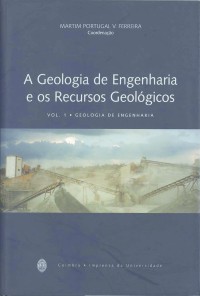Please use this identifier to cite or link to this item:
https://hdl.handle.net/10316.2/39160| DC Field | Value | Language |
|---|---|---|
| dc.contributor.author | Sá, A. A. | |
| dc.contributor.author | Ferreira, M. Portugal | |
| dc.contributor.author | Pires, C. C. | |
| dc.date.accessioned | 2016-07-28T16:08:01Z | |
| dc.date.accessioned | 2020-09-19T22:16:11Z | - |
| dc.date.available | 2016-07-28T16:08:01Z | |
| dc.date.available | 2020-09-19T22:16:11Z | - |
| dc.date.issued | 2003 | - |
| dc.identifier.isbn | 972-8704-14-3 | |
| dc.identifier.isbn | 978-989-26-0321-6 (PDF) | |
| dc.identifier.uri | https://hdl.handle.net/10316.2/39160 | - |
| dc.description.abstract | A decade after the opening of the IP4 (principal itinerary Porto-Bragança) between Mirandela and Macedo de Cavaleiros, it is stimulating and possible to evaluate the amount of rock material removed from the excavated slopes, in the intermediate to low grade metamorphic Lower Palaeozoic rock units along a segment of twenty kilometres. These units comprehend the quartzphyllites, greenstones and greenschists, metarhyolites and metamorphic tuffs and tuffites of a broad synform. The deterioration types, the volume of the debris, the major dimension of the rock fragments and the length of deteriorated sites are evaluated against the rock types, the density, orientation and opening of the descontinuities, degree of weathering, geometry of the slope and the prevalent foliation. The deterioration susceptibilities (RDA+e) found for the whole length of these highway slopes, range from 54 to 99 (the full interval ranges from 6 to 160). It can be tested against an attempted index of actual deterioration of the slopes (ADS) which is found to range between 8 and 18 (the full interval is 4 to 20). It has been found that these two indices show a positive correlation expressed as ADS = 0,26RDA - 5,64 for an R2 = 0,56. If it were used the (RDA+e), the correlation would be worse. The most deteriorated segment is located in the thermally recrystalized and preferentially fractured volcano-sedimentary units that crop out in the western limb of the Romeu antiform. | eng |
| dc.description.abstract | Uma década após a abertura do troço do IP4 entre Mirandela e Macedo de Cavaleiros (itinerário principal Porto-Bragança) é estimulante avaliar a quantidade de material rochoso caído dos taludes escavados em rochas metamórficas do Paleozoico Inferior, numa extensão de vinte quilómetros. Estas unidades compreendem quartzofilitos, xistos verdes, metarriolitos, tufos metamórfico e tufitos de uma sinforma aberta. Os tipos de deterioração, o volume de detritos, a dimensão dos maiores fragmentos rochosos e a extensão dos locais deteriorados foram avaliados tendo em atenção o tipo de rochas, a densidade, a orientação e abertura das descontinuidades, o grau de alteração, a geometria do talude e a foliação predominante. As susceptibilidades de deterioração (RDA+e) encontradas para a extensão total destes taludes situam-se no intervalo 54 a 99 (o intervalo total varia entre 6 e 160); foram testadas contra um índice de deterioração real dos taludes, aqui proposto como ADS, o qual varia entre 8 e 18 (o intervalo total vai de 4 a 20). Os índices RDA apresentam uma correlação positiva que se expressa como ADS = 0,26RDA - 5,64 para um R2 = 0,56. Se fosse usado o (RDA+e) a correlação seria mais pobre. O segmento mais deteriorado encontra-se nas unidades vulcano-sedimentares, com recristalização de contacto e preferencialmente fracturadas, do flanco oeste da antiforma do Romeu. | por |
| dc.language.iso | eng | - |
| dc.publisher | Imprensa da Universidade de Coimbra | por |
| dc.relation.ispartof | http://hdl.handle.net/10316.2/2826 | por |
| dc.rights | open access | - |
| dc.subject | artificial slopes | eng |
| dc.subject | stability | eng |
| dc.subject | deterioration | eng |
| dc.subject | factors | eng |
| dc.subject | volcano-sedimentary units | eng |
| dc.subject | debris | eng |
| dc.subject | taludes artificiais | por |
| dc.subject | estabilidade | por |
| dc.subject | deterioração | por |
| dc.subject | factores | por |
| dc.subject | unidades vulcano-sedimentares | por |
| dc.subject | detritos | por |
| dc.title | Slope behaviour in highways: a decade of deterioration in metamorphic rocks with volcano-sedimentary origin along the IP4 (NE Portugal) | por |
| dc.title.alternative | O comportamento de taludes de rodovias: uma década de deterioração em rochas metamórficas de origem vulcano-sedimentar ao longo do IP4 (NE Portugal) | eng |
| dc.type | bookPart | por |
| uc.publication.collection | Investigação | por |
| uc.publication.firstPage | 367 | - |
| uc.publication.lastPage | 375 | - |
| uc.publication.location | Coimbra | por |
| dc.identifier.doi | 10.14195/978-989-26-0321-6 | - |
| uc.publication.section | Decaimento de rochas e agregados | por |
| uc.publication.digCollection | PB | por |
| uc.publication.orderno | 24 | - |
| uc.publication.area | Ciências da Engenharia e Tecnologias | por |
| uc.publication.bookTitle | A geologia de engenharia e os recursos geológicos. Vol. I: Geologia de Engenharia | - |
| uc.publication.manifest | https://dl.uc.pt/json/iiif/10316.2/39160/222365/manifest?manifest=/json/iiif/10316.2/39160/222365/manifest | - |
| uc.publication.thumbnail | https://dl.uc.pt/retrieve/11352132 | - |
| uc.publication.parentItemId | 56823 | - |
| uc.itemId | 72620 | - |
| item.fulltext | With Fulltext | - |
| item.grantfulltext | open | - |
| Appears in Collections: | A geologia de engenharia e os recursos geológicos. Vol. I: Geologia de Engenharia | |
Files in This Item:
| File | Description | Size | Format | |
|---|---|---|---|---|
| slope_behaviour_in_highways.pdf | 2.5 MB | Adobe PDF |  |
Items in DSpace are protected by copyright, with all rights reserved, unless otherwise indicated.
